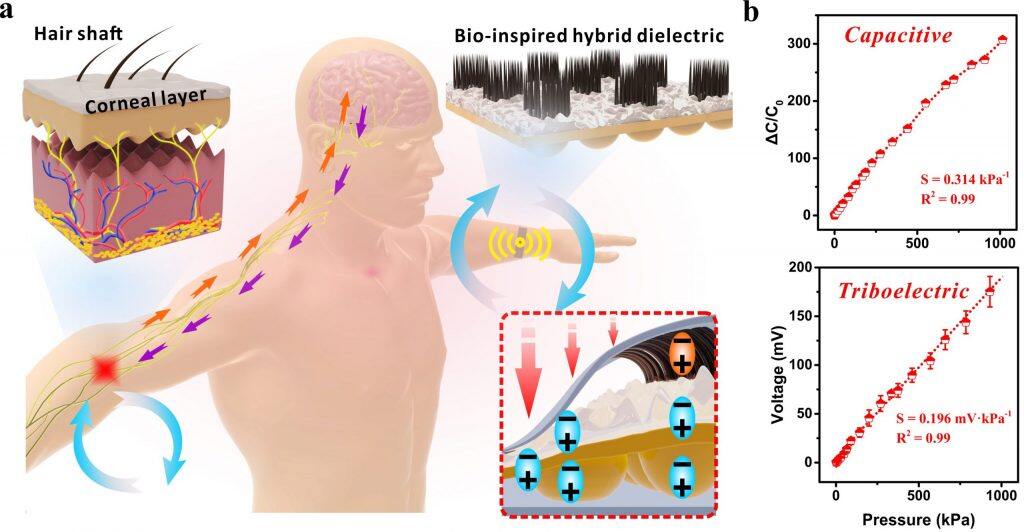A research team led by Zhou Bingpu, an assistant professor in the Institute of Applied Physics and Materials Engineering (IAPME), University of Macau (UM), has designed a novel hybrid dielectric that simultaneously enables high sensitivity and ultra-wide linearity range of wearable and flexible capacitive/triboelectric tactile sensors. The proposed sensors can operate without external power supply and can be applied for health monitoring, human-machine interaction, and intelligent control. The study has been published in Advanced Materials, a leading academic journal in the field.


b) Ultra-wide linear sensing of flexible capacitive and triboelectric tactile sensors
In recent years, wearable and flexible sensors have attracted a lot of attention for their potential applications in areas such as healthcare monitoring, electronic skin, and intelligent communication. However, the synergistic optimisation of key parameters, such as sensitivity, linearity, and detection range, is still an important factor limiting their further development for practical applications. The effective working range of capacitive flexible tactile sensors is often limited to 10 to 100 kPa because of the non-linear dielectric behaviour of the dielectric layer and mechanical deformation, and it is difficult to simultaneously optimise key parameters such as sensitivity and linearity. The co-existence of wide linearity and high sensitivity enables the preserved detection capability across a broad pressure range, which not only favours the applications for different scenarios, but also simplifies the subsequent extraction and analysis of the electric signal.
Inspired by the structure of human skin, the research team has designed a novel hybrid dielectric composed of a low-k micro-cilia array, a high-k rough surface, and a micro-dome array. The hybrid dielectric has gradient dielectric properties and compressibility, and can be converted in series and parallel between low-k and high-k components under pressure to meet the linear variation of dielectric and mechanical properties with pressure, thus realising a capacitive sensor with linearity and stable sensitivity over a wide range of up to 1000 kPa. The hybrid dielectric is also suitable for triboelectric tactile sensors, where the hybrid structure with linear dielectric behaviour not only enhances triboelectrification and electrostatic induction, but also enables linear variation in effective surface charge density. As a result, the triboelectric sensor can serve as a self-powered device, effectively converting external tactile stimuli into voltage signals over a wide pressure range of up to 1000kPa, for real-time monitoring of human health and motion detection.
Because of the high sensitivity and ultra-wide linearity range, the sensor maintains a high resolution over a broad range of pressures. Therefore, the proposed sensors can not only perceive the physiological signals of the human body, such as pulse and breathing, in different applications for health monitoring, but can also combine applied external forces and encode capacitive or voltage signals into commands for human-machine interaction and intelligent control. As the output of commands can be realised entirely by a single sensing device, the need for integration of multiple sensing elements and complex signal processing and conversion can be avoided. The design of hybrid dielectric addresses the difficulty of separately regulating the dielectric and mechanical behaviour of conventional dielectrics and provides a novel strategy for the development of high-performance flexible tactile sensors.
The first author of the paper is PhD student Ji Bing in IAPME. This study was funded by the Science and Technology Development Fund, Macao SAR (file number: 0037/2018/A1) and UM (file number: MYRG2017-00089-FST, MYRG2018-00063-IAPME). The full version of the related paper can be viewed at: https://doi.org/10.1002/adma.202100859 .
Source: Institute of Applied Physics and Materials Engineering, University of Macau



































